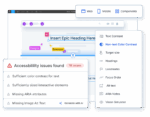
One area in which test automation can deliver big value to organizations is in accessibility.
Accessibility is all about the user experience, and is especially important for users with disabilities. Automated end-to-end testing helps answer the question of how easy or difficult it is for users to engage with the software.
“If the software is crummy, if it’s not responding, you’re going to have a bad experience,” noted Arthur Hicken, technical evangelist at Parasoft. “But let’s say the software has passed the steps of being well-designed and well-constructed. Hicken said, after that, come those accessibility tests, which are, is this really usable and well-suited for humans? And which tasks do humans use most?”
There is nothing innate about test automation that can raise a flag to any issues, unless the model is trained to identify and report, for instance, if any tasks take more than four steps to complete, it should be looked at.
According to Jonathan Wright of Keysight, it’s equally important to be sure the application is usable and accessible in various regional deployments involving different language sets and cultural variations. “I had a call with a large-scale organization and they wanted to know how we could support their multiple different localization deployments, which includes help and documentation. So it’s really the ability to support global rollouts that follow the sun.”
Wright said in large organizations, centers of enablement are being marginalized as self-service takes hold. “I’m in a large organization, what tools and technology do I need? And you know, it’s usually a people problem, not a technology problem. It’s kind of giving them the right tools to be able to help them do the job.”
For accessibility testing, mabl’s Fernando Mattos said companies often will have a different team to do that type of testing. “Many times, it’s a third-party company performing that, along with legal advice. What we’re trying to do is to shift that left and allow the reusability of you having already tested the whole UI. Why recreate all those tests in a separate tool, and why have a different team do it much later after deployment?”
The impact of a poor user experience on digital businesses can involve loss of customers and revenue as users today expect a seamless experience. “In e-commerce, in B-to-C commerce, they’re seeing hypercompetitiveness in the market and customer switching because the page takes a little too long to load,” he said. “And that talks a little bit more about what end-to-end testing is.”
Mattos added that making sure things are working properly has been seen as functional quality, but it’s important for organizations to make sure the performance of the application is fast, that it responds quickly, and the UI shows up quickly. He added that organizations can reuse their functional test cases to check for accessibility, so if a development team is pushing new features, and one introduces a critical accessibility issue that gets caught right at the commit or pull request phase, it can get fixed right away. Mabl, and the industry as a whole, is moving to shift this testing left, rather than performing it just prior to release.
Mattos noted that there are libraries for automated accessibility testing that can be used to catch 55% to 60% of the issues, while the remaining 40-45% of issues have to be done by people with the disability or experts that know how to test for it. But for the 55-60%, mabl pushes those into development and introduces accessibility testing there, instead of waiting for a third-party company or team to duplicate the test and catch an error a week later.






